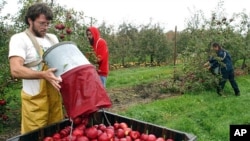Researchers in the U.S. state of Michigan are looking for ways to help apple trees survive bad weather. To do this, one researcher plans to use a late bloomer.
The late blooming tree is a native Michigan apple tree known by the scientific name Malus coronaria. To fight freezing temperatures, the tree blooms two or three weeks later than trees that produce cultivated varieties of apples like Honeycrisp or Red Delicious.
“That doesn’t sound like a lot, but almost always that’s enough for the flowers to escape the killing spring frost,” said Steve van Nocker. He is a professor and plant geneticist at Michigan State University.
Van Nocker wants to identify the genes responsible for the Malus coronaria’s delayed blooms. Then he will use those genes to develop more frost-resistant apple varieties.
Van Nocker’s project is one of many ways researchers and growers are trying to make apples more resilient. They say this is important because of climate change.
Other researchers are making similar efforts.
Jared Buono is the director of Cornell University’s Hudson Valley Research Laboratory in New York state. Buono’s lab is adding solar panels to its experimental orchard. He said growers are experimenting with solar panels in Europe and South Korea. The panels protect fruit from hail and sun damage but also let in light and heat when necessary.
University of Maryland researchers recently announced the development of a more heat-tolerant apple variety. At Penn State University in Pennsylvania, a team built an unmanned vehicle that uses propane fuel to warm trees up as it moves around an orchard.
Buono said these efforts can ease the effects of bad weather. On May 18, 2023, frost damaged trees across New York state and cut apple production by 20 percent.
A recent Washington State University study examined weather in apple growing areas from 1979 to 2022. It said the top apple producing states of Washington, Michigan and New York reported fewer cold days and more warm fall nights than they used to. Washington state also has reported more extreme heat.
The study said warming temperatures could cause trees to come out of dormancy too early and increase the risk of sunburn. This hurts the quality of apples.
Malus coronaria is also called sweet crabapple. It was once so common in Michigan that its blossoms were named the state flower in 1897. But, van Nocker said it appears to be disappearing. The trees that remain often produce little new growth or fruit.
Van Nocker and graduate student Lily Christian recently took cuttings from some trees. They will test them to make sure they are fully Malus coronaria and not a hybrid variety. Then, the cuttings will be grafted onto apple rootstock. They hope to get healthy trees using this method.
Their goal is to identify the genes that cause late blooming and create a variety of apple that can be sold in markets. Van Nocker is also sending seeds to the U.S. Department of Agriculture. If the tree continues to disappear, he hopes to save its genes this way.
Making a later-blooming commercial apple could take more than 10 years. If a Malus coronaria is crossbred with a commercial apple tree to make a new hybrid, it would take four or five years for that tree to start producing apples.
Crossbreeding would continue until researchers developed an apple with the desired qualities of both varieties.
But van Nocker said it is important to try.
“With climate change, it’s quite possible that apples won’t be able to be produced in Michigan in the future,” he said. “That’s why cultivar improvement, especially in terms of frost resistance, is so important.”
I’m Anna Matteo.
Dee-Ann Durbin reported this story for the Associated Press from Washington. Anna Matteo adapted it for VOA Learning English.
___________________________________
Words in This Story
bloomer –n. a plant that produces flowers at a certain time of year
cultivated variety –n. a kind of plant that has been specifically developed for use in agriculture or in people’s gardens
frost –n. a layer of ice that can develop on plants when temperatures fall below freezing which damages fruit
resilient –adj. able to withstand shocks or bad treatment and return to normal
orchard –n. an area or farm where fruit trees are grown
solar panel –n. a device that turns sunlight into direct electrical current
tolerant –adj. able to withstand difficult or bad conditions
dormancy –n. a state, during winter or dry conditions, when a plant does not grow but saves its energy for the growing season
hybrid –n. a variety of plant that comes from the combination of genetic material from two or more plants
graft –v. to take a cutting from one plant and attach it to another so that it grows, flowers and produces fruit
rootstock –n. (horticulture) living roots that are combined with the branches of other, similar plants which will grow together with the qualities of both plants
crossbreed –v. to use one of several methods to combine the genetic qualities to make an improved plant
commercial -adj. designed mainly for profit









Forum